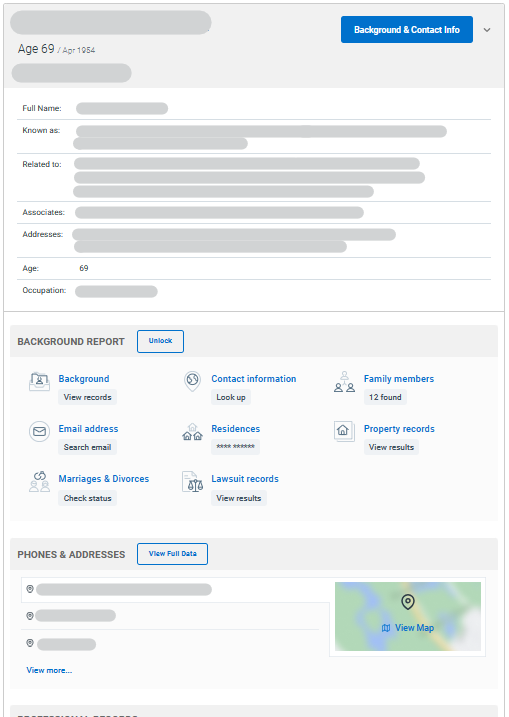How to Remove Your Data from People-Finder Sites
Laura Martisiute
Reading time: 7 minutes

Table of Contents
Follow our guide below to learn how to remove your data from people-finder sites.
Let’s be honest – the chances of getting a message from a long-lost friend who found you through a people finder site are slim.
On the other hand, being scammed, doxxed, harassed, turned down for a job or house, or seeing your insurance premium rise as a result of your personal data appearing on a people finder site are… less slim.
To stop your personal details from being sold to just about anyone, you need to opt out from people finder sites.
What Are People Finder Sites?
People-finder sites, also known as people search sites or data brokers, collect your personal info from public sources and compile it into comprehensive profiles.
Some of the data they collect comes from social media (such as Facebook, LinkedIn, or Instagram), and some from public records (such as court and criminal records). The rest might come from other third parties, including other data brokers.
A typical people finder profile contains information like your full name, date of birth, home address, phone number, family member details, employment, bankruptcies, etc.

Sometimes, this information is available for free. Other times, you might have to pay a small fee to view someone’s profile.
How to Remove Your Data from People Finder Sites
While it isn’t illegal for people search websites to publish and sell profiles of your personal information, that doesn’t mean you have to put up with your data being sold.
Most people finder sites let you opt out from their databases, and although it’s a time-consuming process, it’ll help you reduce the amount of personal data that exists about you online.
Here’s how to remove your personal data from people finder sites.
1. Google your name
To start, you’ll need to determine what people-finder sites have profiles on you. Go to Google Search (or a search engine of your choice) and enter your full name. You may also need to add geographic details (such as the city and/or state you live in) to get an accurate match.
Take note of any people-finder websites offering information on you (common sites include PeekYou, Whitepages.com, US Search, and ZabaSearch).
Add them to a list of data brokers to contact and request your profile removed from, as they will often be among the first stops for bad actors with malicious intent who are looking for information about you (such as doxers or stalkers).
2. Look yourself up on people finder sites that did not appear on Google
Not every people-finder site with a profile on you will appear in Google’s search results. If you’re serious about your online privacy, you’ll need to go to each people finder website and search for your name.
When you find a matching profile, copy its URL. You’ll likely need to provide it later on when opting out.

3. Find the opt-out page
When you’re ready to opt out of a people-finder site’s data collection services – or, to put it another way, when you’re ready to request the removal of your personal information from their database – your next step is to find their opt-out page.
Most people-finder sites have an opt-out page viewable from the footer or FAQ sections.

The opt-out page should have instructions on how to remove your profile from that particular website.
4. Submit an opt out request
The opt-out process varies from one data broker to the next.
Some people-finder sites have opt-out forms that you can fill out and submit, while others require you to email them specific information (sometimes even requiring you to verify your identity).
Follow each data broker’s instructions on the site’s opt-out page.
Check out our free DIY data broker opt out guides if you need help. Some of our most popular guides are:
- How to remove yourself from Whitepages.
- How to remove yourself from Spokeo.
- How to remove yourself from BeenVerified.
- How to remove yourself from PeopleFinder.
- How to remove yourself from Radaris.
- How to remove yourself from People Background Check.
- How to remove yourself from TruthFinder.
- How to remove yourself from MyLife.
- How to remove yourself from Intelius.
- How to remove yourself from Fast People Search
- How to remove yourself from Arrests.org.
- How to remove yourself from CheckPeople.com
- How to remove yourself from Instant Checkmate.
When submitting your opt out request, remember that you’re dealing with a data broker. Be very careful about what you share – including your real email address. Most data brokers require you to click on a confirmation email before they accept your opt out request. You may want to set up a temporary account or use a masked email to avoid unwittingly giving out your contact information.
Some data brokers maintain multiple profiles on the same person. Make sure to include each profile that’s connected to you in the removal request.
5. Repeat the process for each site
Since people-finder sites operate in isolation, you will need to repeat the opt out process for each one that has a profile on you.
Remember to reference Google search results and manually check data broker websites to find any profiles connected with your identity.
6. Repeat the process in a few months time
Unfortunately, opting out of a people-finder site doesn’t mean that you’ll be removed from it forever. People search websites frequently refresh their databases, creating new profiles when they find new information about you.
This means you’ll need to go back to each people finder site a few months after you opt out to see if your profile has reappeared.
If a new profile has appeared, you’ll have to repeat the removal process.
Alternatively, you can subscribe to a data broker removal service like DeleteMe. Our privacy experts will continuously opt you out of people-finder sites on your behalf.
Why Is My Information On People Finder Sites?
Data is valuable, and that means that data brokers are interested in selling your sensitive information whether you’re aware of it or not.
As long as your information is publicly available on social media platforms, public records, and online accounts, it’s at risk for collection by people-finder sites, who will compile it into a profile and sell it.
Since the information they deal in is public, data brokers aren’t breaking the law by selling it, even though you haven’t given consent.
Having your personal information for sale like that doesn’t just impinge on your privacy; it can actually harm you. Anyone can use people search sites and data brokers (doxxers, stalkers, scammers, hackers, advertisers, etc.) to find your personal information and target you with personalized ads, hack into your accounts, send you scams, or commit identity theft.
You can minimize your exposure to people-finder websites by limiting what you share on the internet. Change the privacy settings on your social media profiles, remove your contact information from public facing accounts, and avoid including personal details in your posts and comments.
Our privacy advisors:
- Continuously find and remove your sensitive data online
- Stop companies from selling your data – all year long
- Have removed 35M+ records
of personal data from the web
Save 10% on any individual and
family privacy plan
with code: BLOG10
news?
Don’t have the time?
DeleteMe is our premium privacy service that removes you from more than 750 data brokers like Whitepages, Spokeo, BeenVerified, plus many more.
Save 10% on DeleteMe when you use the code BLOG10.
















